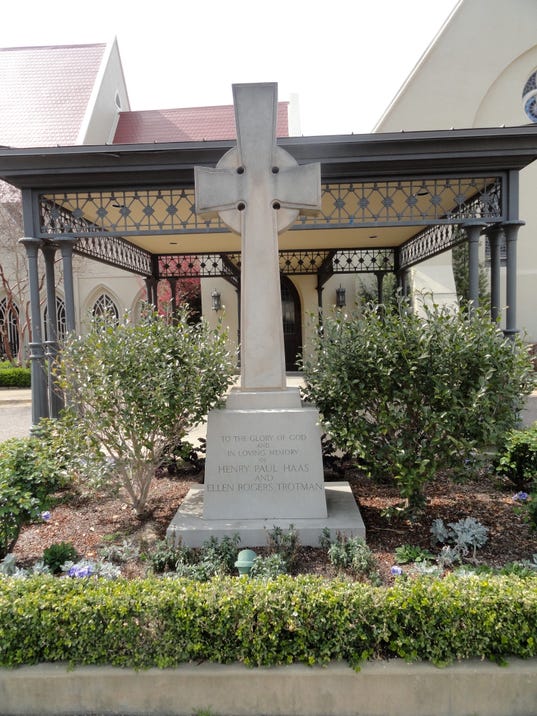Jeff Benton September 27, 2014
This is the Celtic cross at St. John’s Episcopal Church, Christchurch XP Anglican and First United Methodist Church. (Photo: contributed )
Today, the cross is the universal symbol of Christianity. It was not always so. In the early centuries after the time of Jesus Christ, there were other symbols: a dove, a ship, an anchor and a lyre. The best known of these early symbols is the fish. Koine Greek was the common language of the eastern Mediterranean, the language of education in the Roman Empire, and the language of the Christian New Testament. The Greek for fish, ichthus, served as an acronym for “Jesus Christ, Son of God, Saviour.”
The cross itself, either as a vertical stake without a crossbar or as a vertical member with a crossbar was not used. It had the negative connotation of the horrific public execution of criminals.
The first two cross-like visual representations of the crucifixion were oblique references to the crucifixion and were based on Greek letters. The vertical tau was surmounted by the curled rho; the tau represented the cross, and the rho Christ’s head. The tau-rho dates to the late second century.
The second of these early representations of the crucifixion is the chi-rho, which is associated the Emperor Constantine the Great at the beginning of the fourth century. The chi-rho, sometimes depicted in the Latin alphabet as XP, is still used today.
Although making the sign of the cross — forehead, breast, shoulders — is known to have dated from at least as early as the beginning of the second century, it was not part of Christian iconography, or symbols, until the fourth century. Then, explicit depictions of the crucifixion first occurred as an empty cross. However, the crucifix itself, with the dead Jesus on the cross, did not appear until the sixth century.
In any case, from at least the early second century, Christianity and the cross were so closely connected that Christians were accused of worshiping the cross.
The Roman Catholic and Eastern Orthodox churches use the crucifix as a focus of religious devotion, as do some Lutheran and Anglican parishes. In general, however, most Protestant denominations have — until recently perhaps — rejected sacred images and religious art. Crosses, especially the Latin cross, no longer raise questions in most Protestant churches, although crucifixes still do.
Perhaps as popular as statues of St. Francis of Assisi — the most popular image of a saint for Protestants — is the Celtic cross. This cross is a Latin cross superimposed on a circle at the intersection of the upright and crossbar. Considering its probable origin, its popularity could be surprising.
Legend has it that in the early fifth century, St. Patrick combined the Christian cross and the pagan circle, symbolic of the Celtic sun god. Alternatively, it could be symbolic of the supremacy of Christ over the Celtic sun god. It is probably an example of syncretism, the combination of two or more religions, considering that Celtic Christianity retained many beliefs and practices of Celtic paganism. No surviving Celtic crosses date from this early period of Christianity in Ireland.
By the eighth century, high crosses were set up across Ireland. These free-standing crosses, often covered with sculpted images, took the basic Celtic cross form. The Celtic cross died out about 1200; by that time Roman Catholic Christianity had been dominant in the British Isles for several centuries.
The Celtic cross form can also be found in Scotland and the north of England. Variants can be found in the west of France and the northwest of Spain, once both Celtic areas.
In the mid-19th century, with the Celtic Revival that was associated with Irish nationalism, free-standing Celtic crosses were again erected in Ireland, especially in cemeteries. These were much more simple and more likely to be standardized in their form than the ancient high crosses. The practice spread from Dublin throughout Ireland and to the rest of the world.
The popularity of the Celtic cross should not be surprising: it has lost its original association with the Celtic sun god. The obelisk has also lost its original symbolism as a sunray of the Egyptian sun god, Ra.

